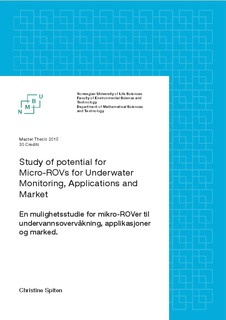| dc.contributor.author | Spiten, Christine | |
| dc.date.accessioned | 2015-07-30T09:19:21Z | |
| dc.date.available | 2015-07-30T09:19:21Z | |
| dc.date.copyright | 2015 | |
| dc.date.issued | 2015-07-30 | |
| dc.identifier.uri | http://hdl.handle.net/11250/293947 | |
| dc.description.abstract | The need for underwater monitoring has increased significantly as more and more industries are based on marine resources, such as energy, food production and transportation. Along with these industries other services have also been established within safety and rescue, and scientific research have increased.
This report constitutes a feasibility study of micro-ROVs as tools for underwater monitoring, focusing primarly on three market areas;
1. Environmental monitoring – specifically on coral reefs 2. Aquaculture
3. Rescue and safety service
By introducing the reader to the history of underwater technology, from the first attempts for humans to stay under water, to today’s technology, that has taken us down to the deepest point on Earth, this report gives an understanding of the background for exploring the urge and work behind us on the evolution in this field.
The aim of this project is to identify potential applications for small ROVs and on the basis of these propose solutions to meet existing market needs. Existing concepts are examined and compared with each other, and interviews and discussions with experts from each industry are undertaken to uncover "where the shoe pinches" and potential needs for micro ROVs.
Based on the findings from this research, technical tests have been conducted to determine whether OpenROV v2.7 meets the various sectors' needs, and reveal possible improvements.
Furthermore, there is developed a concept in which sensors for pH and oxygen measurement is implemented on an OpenROV and testing of the concept is done. On the basis of these tests it is suggested modifications and enhancements to further work.
OpenROVen is compared with alternative solutions for underwater surveillance and cost, availability and ease of use are analyzed and presented at the end of this study.
It has been shown in this thesis that there is need for micro-ROVs for surveillance within the concerned industries, and that it is feasible to meet these needs. It was also determined that the price is an important factor for the degree of implementation of such systems within smaller enteties. There are however many uncertainties, since a large part of the study is conducted theoretical and since the developed models have not been tested under real conditions. | nb_NO |
| dc.language.iso | eng | nb_NO |
| dc.publisher | Norwegian University of Life Sciences, Ås | |
| dc.subject | Robotics | nb_NO |
| dc.subject | Underwater monitoring | nb_NO |
| dc.subject | ROV | nb_NO |
| dc.subject | Technology | nb_NO |
| dc.subject | Aquaculture | nb_NO |
| dc.title | Study of potential for micro-ROVs for underwater monitoring, applications and market | nb_NO |
| dc.title.alternative | En mulighetsstudie for mikro-ROVer til undervannsovervåkning, applikasjoner og marked | nb_NO |
| dc.type | Master thesis | nb_NO |
| dc.subject.nsi | VDP::Mathematics and natural science: 400::Physics: 430::Electronics: 435 | nb_NO |
| dc.subject.nsi | VDP::Technology: 500::Marine technology: 580::Other marine technology: 589 | nb_NO |
| dc.subject.nsi | VDP::Agriculture and fishery disciplines: 900::Fisheries science: 920::Fisheries technology: 924 | nb_NO |
| dc.source.pagenumber | 70 | nb_NO |
| dc.description.localcode | M-IØ | nb_NO |
